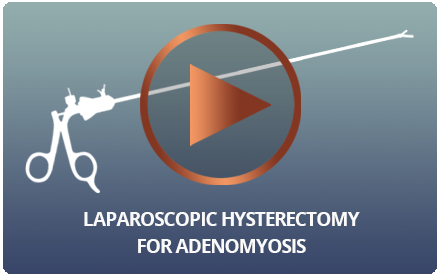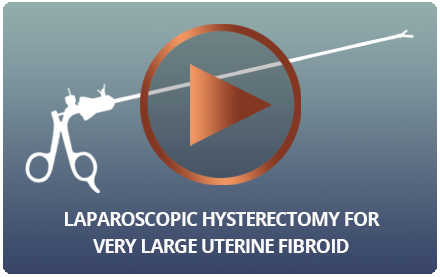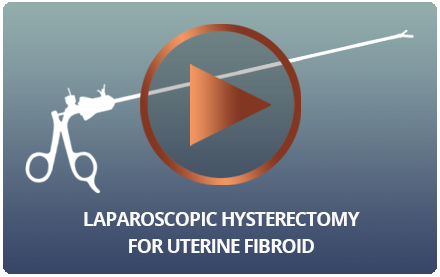Laparoscopic Hysterectomy
What is a Laparoscopic Hysterectomy?
A laparoscopic hysterectomy (also known as total laparoscopic hysterectomy) is an advanced, minimally-invasive surgical procedure using keyhole surgery to treat several serious medical conditions. It involves the complete removal of the uterus and cervix through small abdominal incisions or via the vagina after they have been detached from surrounding organs and tissue. In comparison, a conventional hysterectomy is conducted through open surgery and involves large incisions on the abdomen (between 5 to 7 inches),
Dr G will explain all your treatment options to you in detail and advise you about the one most suited for your case after assessing your health status, medical history, and outcome requirements.
Advantages of Laparoscopic Hysterectomy
A laparoscopic hysterectomy offers you several advantages over open surgery. These include:
- a quicker recovery time, allowing you to resume routine activities soon after the surgery
- a shorter hospital stay (since this is normally an overnight procedure)
- less pain
- the ability to walk early
- minimal scarring
- the ability to drive as early as a few days after the surgery (provided you feel comfortable and are not taking painkillers with sedating effects)
- a lower risk of complications (including the development of clots in your legs and the contraction of hospital-acquired infections)
- a lower risk of developing a vaginal prolapse in the future
Types of Hysterectomy
A hysterectomy results in the partial or complete removal of the uterus. The different types of hysterectomy are:
- Partial hysterectomy. Also known as a supracervical hysterectomy, this procedure necessitates the removal of the upper part of the uterus. The cervix is left intact.
- Total hysterectomy. A total hysterectomy necessitates the removal of both the uterus and the cervix.
- Radical hysterectomy. Commonly used in cases of uterine cancer, a radical hysterectomy involves the excision of the uterus, upper portion of the vaginal, and cervical tissue.
A hysterectomy does not involve the removal of either or both ovaries. Removing the ovaries (a process known as oophorectomy) can be done at the same setting only if clinically indicated.
How is a Total Laparoscopic Hysterectomy Performed?
A total laparoscopic hysterectomy is performed in an operating theatre. After you have been given general anaesthesia, Dr G will make a small incision below your navel. Your abdomen will then be inflated with carbon dioxide — a process known as Insufflation. Insufflation both increases workroom and improves visual clarity. A thin, fibre-optic medical instrument called a laparoscope will be passed through this incision. After making a few more small incisions on your stomach, Dr G will extract your uterus and cervix with the help of tiny surgical instruments.
For more information on the effects of carbon dioxide on the human body, visit our page on Insufflation.
Risks Associated with a Total Laparoscopic Hysterectomy
As with all other types of surgery, a total laparoscopic hysterectomy carries its share of risks and complications. These include:
- Infections (internal or external)
- Blood clots in the pelvis, legs, or lungs
- Post hysterectomy pain
- Accidental injury to internal organs or structures
- Nausea and vomiting
- Adverse reactions to anaesthesia
Most of these risks are extremely rare, however. Dr G will discuss them with you at the time of your consultation.
When is a Laparoscopic Hysterectomy Needed?
A laparoscopic hysterectomy can be used to treat a variety of problems. These include:
- Endometriosis: This gynaecological disorder affects women of childbearing age. It is characterised by the abnormal growth of endometrial tissue on the exterior of the uterus and surrounding organs (ovaries, fallopian tubes etc.). Symptoms include painful menstrual cramps, lower back pain, heavy menstrual flow, and fertility problems, amongst others.
- Menorrhagia: This disorder is characterised by a very heavy period flow. It is also associated with the passing of large clots and gushes of blood (flooding) during menstruation.
- Uterine fibroids: These are non-cancerous uterine growths of various sizes. They may grow inside the uterus, within the uterine walls, and/or outside the uterus. Thought to be influenced by the hormone estrogen, the fibroids can result in a number of problems for women including heavy menstruation, painful cramps, infertility, and bladder dysfunction, amongst others.
Uterine Prolapse: A uterine prolapse occurs when a woman’s uterus slips out of its normal position and drops into the vaginal canal. It can happen when the connective tissue and muscles that hold the uterus in position are weakened or damaged. There are several risk factors that are associated with uterine prolapses. These include vaginal births, aging, chronic coughs, obesity, and low levels of estrogen post-menopause. Common symptoms include vaginal lumps, vaginal bleeding, bladder infections, bladder dysfunction, and painful intercourse, amongst others. For more information on this condition, its symptoms, and treatment, visit our pages on Pelvic Organ Prolapses and Genital Prolapse Management.
Other problems that can necessitate a hysterectomy include uterine cancer, ovarian cancer, adenomyosis (uterine muscle thickening), and uncontrolled vaginal bleeding. It must be noted that a hysterectomy is not recommended to women who wish to conceive in the future and is usually considered a last-resort treatment. Dr G will first attempt to treat your case through medicines and less-aggressive corrective procedures. A hysterectomy will be recommended only if you don’t respond to any of these treatments or if you have ovarian or uterine cancer.
Important
You need to seek medical attention immediately if you experience any of these problems after your hysterectomy surgery:
- Fever
- Abnormally heavy bleeding
- Offensive vaginal discharge
- Severe nausea or vomiting
- Difficulty emptying your bladder or bowel
- Extreme pain
Post Hysterectomy
After a hysterectomy, you must abstain from sexual intercourse, vigorous physical activity, and heavy lifting for around six weeks. Women who have had conventional hysterectomies typically enter menopause at an earlier age than they normally would. Women who have laparoscopic hysterectomies, on the other hand, are less likely to develop premature menopause—particularly when in the care of an experienced surgeon like Dr G. Please visit our page on Life After a Hysterectomy to know what to expect after the completion of your laparoscopic hysterectomy.



